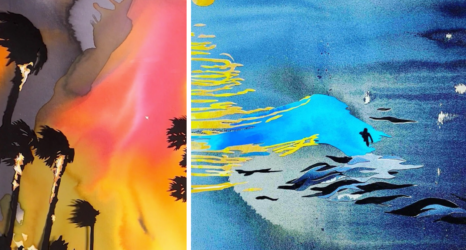The British artist Tracey Emin is famous for uncompromising displays of female vulnerability in the most fleshly and confessional of forms. From the dirty underwear and tampons of her 1998 “My Bed” installation to the visceral sexuality of her autobiographical paintings, Emin’s work is filtered through a desirous—and often distressed—mortal body defined by a raging sense of lack. This emotional and physical neediness has shaped the reception of her new Hong Kong exhibition, “I Cried Because I Love You,” in which several drawings recall Emin’s ritual of marriage to a large stone on her property in the South of France.
Across the press, Emin’s seemingly perverse act of union has been framed in terms of female loneliness—a Bridget Jones-style yearning for a man “as solid as a rock,” conceived as refuge from a dystopian dating scene. Writing in the Guardian, Gaby Hinsliff suggests that after addressing taboo aspects of female sexuality from rape to abortion, Emin “is now drilling down to the most dangerously provocative idea of the lot, namely the possibility of building a life without a man at its center.”
Speaking to The Art Newspaper, Emin has certainly encouraged such an interpretation, claiming, “It just means that at the moment I am not alone; somewhere on a hill facing the sea, there is a very beautiful ancient stone, and it’s not going anywhere. It will be there, waiting for me.” Solidity, stability, permanence: the stone embodies all the qualities that seem to have been missing from the turbulent romantic life the artist has displayed so nakedly in her work. In this sense, it stands as a fittingly monumental and steadfast response to the roll call of names appliquéd onto the flimsy canvas of her tent, “Everyone I Have Ever Slept With 1963-1995,” itself destroyed in the Momart warehouse fire of 2004. As Emin has commented, “Even if there’s the biggest f***ing tsunami in the whole f***ing world, the stone will probably still stay there.”
Stone may play the part of bridegroom here, but it is also an artistic medium. In her focus on fiber arts and drawing, Emin generally skews towards more conventionally “feminine arts,” reclaiming them with a ferocity of expression that also conspicuously disavows the monumentality and durability of media such as stone sculpture. In marrying her stone, however, she situates herself within a long line of male artists. Emin’s act is nothing less than an ingenious feminist hack of a myth central to the foundation of art itself—the story of Pygmalion.
In Ovid’s telling of the Pygmalion myth, the artist is spellbound by the beauty of the woman he has carved, but cannot actually marry his love object until the goddess Venus transforms her hard ivory into soft, yielding flesh. Likewise, ancient literature has passed down several tales of men so infatuated with marble statues of Venus that they tried to copulate with them, leaving tell-tale “stains” upon the goddess’s thigh. In one version recounted by the Greek author Athenaeus, this tension between stone and flesh is taken to its logical conclusion when a youth known as Cleisophus the Selymbrian responds to “the cold and unyielding nature of the stone” by “setting out a piece of meat” and having intercourse with that instead. Together, these tales form the beginnings of a sculptural tradition focused on attempts to invest stone with qualities that it does not naturally possess, mastering the medium through fantasies of transformation and possession.
The concept of a Pygmalion-esque marriage takes a rather sinister turn with a statue found, like Emin’s stone, under an olive tree in the South of France. In his 1837 novella The Venus of Ille, the novelist and antiquarian Prosper Merimée recounts the tale of a bridegroom who casually places his engagement ring on the finger of an ancient bronze statue of Venus. The statue’s fingers mysteriously close around the ring, confirming a betrothal that the unfortunate youth is later held to when the Venus crushes him to death in his marital bed. This macabre twist is arguably the logical outcome of a tradition preoccupied with the animation of a naturalistically rendered love object: treated like a human form and charged with “life,” the statue simply responds to the contract established by its human partner.
Should this be a warning to Emin not to trust too blithely in the benign stolidity of her new husband? The Spectator, after all, pointed out that the stone could not exactly consent to its new status. Like the frustrated admirers of ancient Venuses, Emin is no stranger to the sticky residue of sex; used condoms feature predominantly in “My Bed,” while masturbation features in many of her drawings. In her marriage to the stone, however, the artist not only dismisses the notion of carnal union, but also subverts the animating impulses of her male forebears. In the catalogue to her exhibition, Emin draws a pointed contrast between a stone and a rock: a stone “is here forever”; a rock “has been made by things that cut it away.” In contrast to the highly carved and polished bodies of Pygmalion’s beloved and her successors, Emin’s stone is resolutely unworked, non-figural and ungendered. She has made no attempt to transform the medium into something other than itself: rather, the qualities of the uncut stone are precisely what make it a partner worthy of her affections. The more “stony” the stone, the more perfect it is as love object. It does not function as a fetish, for it is neither worshipped nor used for sexual gratification. It simply “is.”
In marrying the stone for its essential qualities, Emin has arguably bestowed upon it one of the greatest gifts that a partner can confer: like an artist who responds to and works with the natural properties of materials, she demands nothing that her stone does not already offer. And in this she not only subverts the Pygmalion narrative but the Bridget Jones one, too: like Mark Darcy, it is she who ultimately has the confidence and the self-possession to say, “I like you very much. Just as you are.”
Get the Ms. Blog in your inbox! Click here to sign up for our newsletter.





